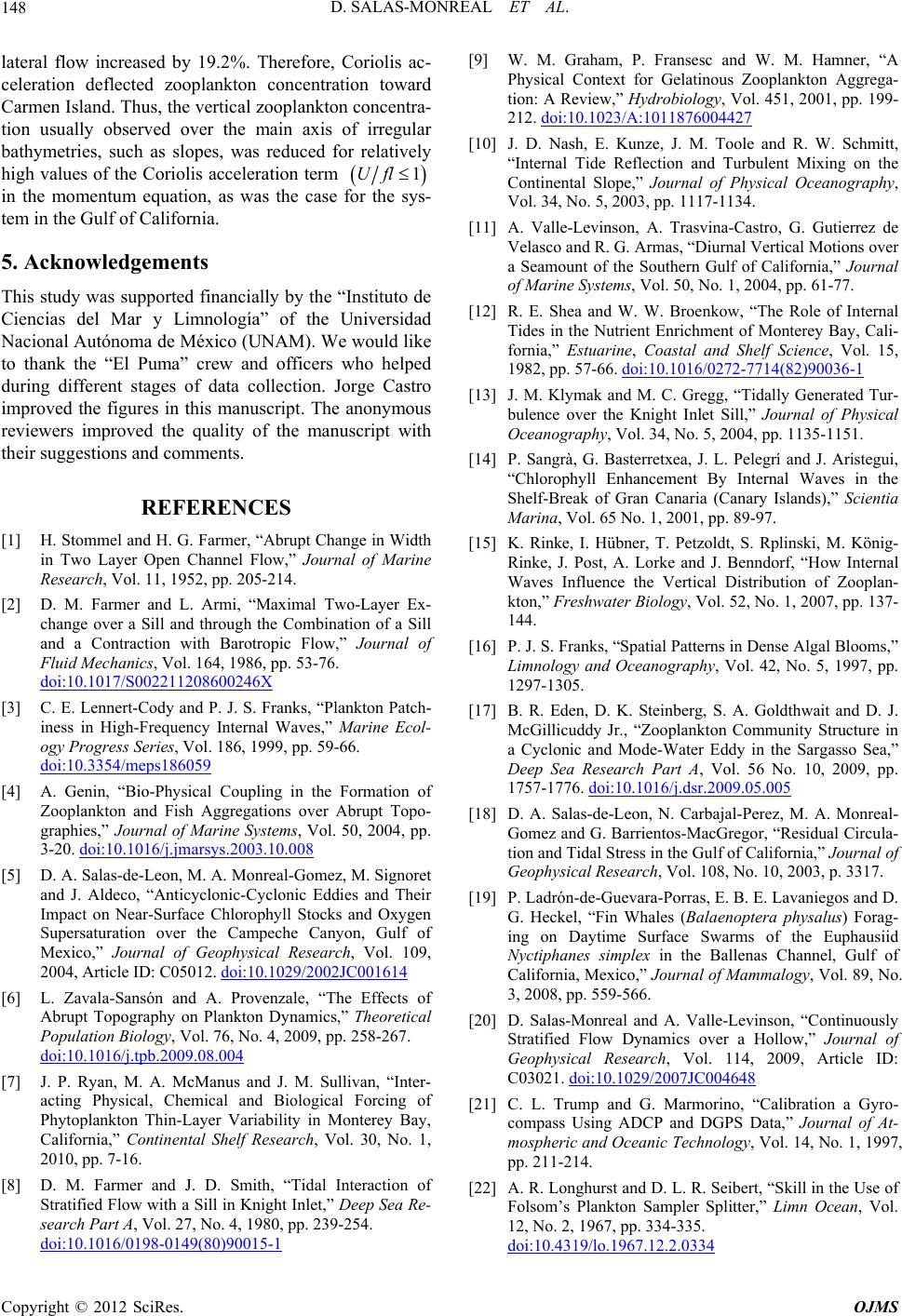
D. SALAS-MONREAL ET AL.
148
lateral flow increased by 19.2%. Therefore, Coriolis ac-
celeration deflected zooplankton concentration toward
Carmen Island. Thus, the vertical zooplankton concentra-
tion usually observed over the main axis of irregular
bathymetries, such as slopes, was reduced for relatively
high values of the Coriolis acceleration term
1Ufl
in the momentum equation, as was the case for the sys-
tem in the Gulf of California.
5. Acknowledgements
This study was supported financially by the “Instituto de
Ciencias del Mar y Limnología” of the Universidad
Nacional Autónoma de México (UNAM). We would like
to thank the “El Puma” crew and officers who helped
during different stages of data collection. Jorge Castro
improved the figures in this manuscript. The anonymous
reviewers improved the quality of the manuscript with
their suggestions and comments.
REFERENCES
[1] H. Stommel and H. G. Farmer, “Abrupt Change in Width
in Two Layer Open Channel Flow,” Journal of Marine
Research, Vol. 11, 1952, pp. 205-214.
[2] D. M. Farmer and L. Armi, “Maximal Two-Layer Ex-
change over a Sill and through the Combination of a Sill
and a Contraction with Barotropic Flow,” Journal of
Fluid Mechanics, Vol. 164, 1986, pp. 53-76.
doi:10.1017/S002211208600246X
[3] C. E. Lennert-Cody and P. J. S. Franks, “Plankton Patch-
iness in High-Frequency Internal Waves,” Marine Ecol-
ogy Progress Series, Vol. 186, 1999, pp. 59-66.
doi:10.3354/meps186059
[4] A. Genin, “Bio-Physical Coupling in the Formation of
Zooplankton and Fish Aggregations over Abrupt Topo-
graphies,” Journal of Marine Systems, Vol. 50, 2004, pp.
3-20. doi:10.1016/j.jmarsys.2003.10.008
[5] D. A. Salas-de-Leon, M. A. Monreal-Gomez, M. Signoret
and J. Aldeco, “Anticyclonic-Cyclonic Eddies and Their
Impact on Near-Surface Chlorophyll Stocks and Oxygen
Supersaturation over the Campeche Canyon, Gulf of
Mexico,” Journal of Geophysical Research, Vol. 109,
2004, Article ID: C05012. doi:10.1029/2002JC001614
[6] L. Zavala-Sansón and A. Provenzale, “The Effects of
Abrupt Topography on Plankton Dynamics,” Theoretical
Population Biology, Vol. 76, No. 4, 2009, pp. 258-267.
doi:10.1016/j.tpb.2009.08.004
[7] J. P. Ryan, M. A. McManus and J. M. Sullivan, “Inter-
acting Physical, Chemical and Biological Forcing of
Phytoplankton Thin-Layer Variability in Monterey Bay,
California,” Continental Shelf Research, Vol. 30, No. 1,
2010, pp. 7-16.
[8] D. M. Farmer and J. D. Smith, “Tidal Interaction of
Stratified Flow with a Sill in Knight Inlet,” Deep Sea Re-
search Part A, Vol. 27, No. 4, 1980, pp. 239-254.
doi:10.1016/0198-0149(80)90015-1
[9] W. M. Graham, P. Fransesc and W. M. Hamner, “A
Physical Context for Gelatinous Zooplankton Aggrega-
tion: A Review,” Hydrobiology, Vol. 451, 2001, pp. 199-
212. doi:10.1023/A:1011876004427
[10] J. D. Nash, E. Kunze, J. M. Toole and R. W. Schmitt,
“Internal Tide Reflection and Turbulent Mixing on the
Continental Slope,” Journal of Physical Oceanography,
Vol. 34, No. 5, 2003, pp. 1117-1134.
[11] A. Valle-Levinson, A. Trasvina-Castro, G. Gutierrez de
Velasco a n d R. G. Armas, “Diurnal Vertical Motions over
a Seamount of the Southern Gulf of California,” Journal
of Marine Systems, Vol. 50, No. 1, 2004, pp. 61-77.
[12] R. E. Shea and W. W. Broenkow, “The Role of Internal
Tides in the Nutrient Enrichment of Monterey Bay, Cali-
fornia,” Estuarine, Coastal and Shelf Science, Vol. 15,
1982, pp. 57-66. doi:10.1016/0272-7714(82)90036-1
[13] J. M. Klymak and M. C. Gregg, “Tidally Generated Tur-
bulence over the Knight Inlet Sill,” Journal of Physical
Oceanography, Vol. 34, No. 5, 2004, pp. 1135-1151.
[14] P. Sangrà, G. Basterretxea, J. L. Pelegrí and J. Aristegui,
“Chlorophyll Enhancement By Internal Waves in the
Shelf-Break of Gran Canaria (Canary Islands),” Scientia
Marina, Vol. 65 No. 1, 2001, pp. 89-97.
[15] K. Rinke, I. Hübner, T. Petzoldt, S. Rplinski, M. König-
Rinke, J. Post, A. Lorke and J. Benndorf, “How Internal
Waves Influence the Vertical Distribution of Zooplan-
kton,” Freshwater Biology, Vol. 52, No. 1, 2007, pp. 137-
144.
[16] P. J. S. Franks, “Spatial Patt erns in Dense Algal Blooms,”
Limnology and Oceanography, Vol. 42, No. 5, 1997, pp.
1297-1305.
[17] B. R. Eden, D. K. Steinberg, S. A. Goldthwait and D. J.
McGillicuddy Jr., “Zooplankton Community Structure in
a Cyclonic and Mode-Water Eddy in the Sargasso Sea,”
Deep Sea Research Part A, Vol. 56 No. 10, 2009, pp.
1757-1776. doi:10.1016/j.dsr.2009.05.005
[18] D. A. Salas-de-Leon, N. Carbajal-Perez, M. A. Monreal-
Gomez and G. Barrientos-MacGregor, “Residual Circula-
tion and Tidal Stress in the Gulf of California,” Journal of
Geophysical Research, Vol. 108, No. 10, 2003, p. 3317.
[19] P. Ladrón-de-Guevara-Porras, E. B. E. Lavaniegos and D.
G. Heckel, “Fin Whales (Balaenoptera physalus) Forag-
ing on Daytime Surface Swarms of the Euphausiid
Nyctiphanes simplex in the Ballenas Channel, Gulf of
California, Mexico,” Journal of Mammalogy, Vol. 89, No.
3, 2008, pp. 559-566.
[20] D. Salas-Monreal and A. Valle-Levinson, “Continuously
Stratified Flow Dynamics over a Hollow,” Journal of
Geophysical Research, Vol. 114, 2009, Article ID:
C03021. doi:10.1029/2007JC004648
[21] C. L. Trump and G. Marmorino, “Calibration a Gyro-
compass Using ADCP and DGPS Data,” Journal of At-
mospheric and Oceanic Technology, Vol. 14, No. 1, 1997,
pp. 211-214.
[22] A. R. Longhurst and D. L. R. Seibert, “Skill in the Use of
Folsom’s Plankton Sampler Splitter,” Limn Ocean, Vol.
12, No. 2, 1967, pp. 334-335.
doi:10.4319/lo.1967.12.2.0334
Copyright © 2012 SciRes. OJMS